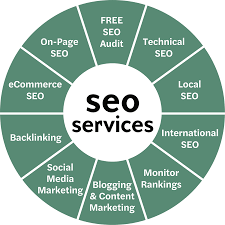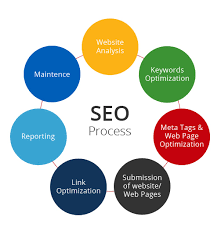Unlocking the Synergy: SEO and Marketing Strategies for Digital Success
The Power of SEO and Marketing in the Digital Age
In today’s digital landscape, the synergy between Search Engine Optimization (SEO) and marketing has become more crucial than ever. SEO and marketing are two sides of the same coin, working hand in hand to elevate a brand’s online presence and drive targeted traffic to its website.
SEO: The Foundation of Online Visibility
SEO is the cornerstone of any successful digital marketing strategy. By optimising a website’s content, structure, and technical aspects according to search engine algorithms, businesses can improve their organic search rankings and attract more qualified leads. Effective SEO not only enhances visibility but also builds credibility and trust among users.
Marketing: Crafting Compelling Messages
Marketing complements SEO by creating compelling messages that resonate with the target audience. Through various channels such as social media, email campaigns, and content marketing, marketers engage with potential customers and nurture relationships that lead to conversions. A well-crafted marketing strategy amplifies the impact of SEO efforts by driving traffic and encouraging user engagement.
The Synergy Between SEO and Marketing
When combined strategically, SEO and marketing form a powerful duo that maximises a brand’s online reach. By aligning keyword research with content creation, marketers can produce valuable resources that not only attract visitors but also convert them into loyal customers. Additionally, data-driven insights from SEO analytics inform marketing decisions, enabling businesses to refine their messaging for optimal results.
Adapting to Changing Trends
In an ever-evolving digital landscape, staying ahead of trends is essential for success. Both SEO and marketing professionals must continuously adapt their strategies to meet changing consumer behaviours and search engine algorithms. By embracing innovation and leveraging new technologies, businesses can maintain a competitive edge in an increasingly competitive market.
Conclusion
In conclusion, the integration of SEO and marketing is essential for businesses looking to thrive in the digital age. By harnessing the power of both disciplines cohesively, brands can increase their online visibility, drive targeted traffic, and ultimately achieve their business goals. As technology continues to evolve, embracing a holistic approach that combines SEO with innovative marketing tactics will be key to sustained success in today’s fast-paced digital world.
Essential Insights: Understanding the Impact and Integration of SEO in Marketing Strategies
- What is SEO and why is it important for marketing?
- How does SEO help improve website visibility?
- What are the key components of a successful SEO strategy?
- How can social media marketing complement SEO efforts?
- What role does content creation play in SEO and marketing?
- How do backlinks impact SEO performance?
- What are the benefits of local SEO for small businesses?
- How can PPC advertising be integrated with SEO strategies?
- What metrics should be monitored to measure the effectiveness of an SEO and marketing campaign?
What is SEO and why is it important for marketing?
Search Engine Optimization (SEO) is a fundamental aspect of digital marketing that focuses on enhancing a website’s visibility and ranking on search engine results pages. SEO involves various strategies and techniques aimed at improving the quality and relevance of a website’s content to align with search engine algorithms. It is crucial for marketing because a strong SEO strategy can drive organic traffic to a website, increase brand awareness, and attract qualified leads. By optimising for relevant keywords and providing valuable content, businesses can establish credibility, build trust with their audience, and ultimately boost conversions. In essence, SEO plays a vital role in ensuring that a brand’s online presence is not only discoverable but also impactful in reaching its target market effectively.
How does SEO help improve website visibility?
Search Engine Optimization (SEO) plays a pivotal role in enhancing website visibility by optimising various elements that search engines consider when ranking web pages. By strategically incorporating relevant keywords, improving website structure and navigation, and creating high-quality content, SEO helps websites climb the search engine results pages (SERPs). This increased visibility not only attracts more organic traffic but also establishes credibility and trust among users. Furthermore, by adhering to SEO best practices and staying abreast of algorithm updates, websites can maintain and improve their visibility over time, ultimately driving more targeted traffic and potential customers to their online platforms.
What are the key components of a successful SEO strategy?
When considering the key components of a successful SEO strategy, several crucial elements come to light. Firstly, thorough keyword research is paramount to identify relevant terms and phrases that align with the target audience’s search intent. On-page optimization, including meta tags, headings, and high-quality content creation, plays a significant role in enhancing website visibility and user experience. Off-page factors such as backlink building and social signals also contribute to establishing domain authority and credibility in the eyes of search engines. Regular performance analysis, technical SEO audits, and staying abreast of algorithm updates are essential for adapting and refining the strategy for sustained success in the ever-evolving digital landscape.
How can social media marketing complement SEO efforts?
Social media marketing plays a pivotal role in complementing SEO efforts by enhancing brand visibility, driving website traffic, and fostering engagement with the target audience. By strategically leveraging social media platforms to share valuable content, businesses can increase their online presence and reach a wider audience. Social signals from platforms like Facebook, Twitter, and Instagram can also impact search engine rankings, further boosting a website’s visibility in organic search results. Moreover, social media provides an avenue for building relationships with customers, encouraging user-generated content, and amplifying brand messaging—all of which contribute to a comprehensive digital marketing strategy that synergises with SEO efforts for optimal results.
What role does content creation play in SEO and marketing?
Content creation plays a pivotal role in both SEO and marketing strategies. In the realm of SEO, high-quality and relevant content is fundamental for improving search engine rankings, driving organic traffic, and enhancing user experience. Search engines value fresh, informative content that aligns with user intent, making content creation a key factor in boosting visibility and authority online. From a marketing perspective, compelling content serves as a powerful tool to engage audiences, build brand awareness, and foster meaningful connections with customers. By crafting valuable and shareable content across various channels, businesses can not only attract potential customers but also nurture relationships that lead to conversions and long-term loyalty. In essence, content creation forms the backbone of successful SEO and marketing campaigns by delivering value to both search engines and target audiences alike.
How do backlinks impact SEO performance?
Backlinks play a pivotal role in determining the SEO performance of a website. These external links act as signals of credibility and authority to search engines, indicating that the linked site is trustworthy and relevant. High-quality backlinks from reputable sources can significantly boost a site’s search engine rankings, leading to increased visibility and organic traffic. Conversely, low-quality or spammy backlinks can have a detrimental effect on SEO performance, potentially resulting in penalties from search engines. Therefore, cultivating a strong backlink profile through strategic link building efforts is essential for enhancing SEO performance and establishing a reputable online presence.
What are the benefits of local SEO for small businesses?
Local SEO offers a multitude of benefits for small businesses looking to enhance their online presence and attract nearby customers. By optimising their online presence for local searches, small businesses can increase visibility in their target geographic area, making it easier for potential customers to find them when searching for relevant products or services. This targeted approach not only improves search engine rankings but also boosts brand credibility and trust within the local community. Furthermore, local SEO helps small businesses stand out against larger competitors by providing a level playing field to showcase their offerings to local consumers actively seeking nearby solutions. Ultimately, investing in local SEO can drive more foot traffic, phone calls, and website visits, leading to increased sales and sustainable growth for small businesses.
How can PPC advertising be integrated with SEO strategies?
Integrating PPC advertising with SEO strategies can significantly enhance a brand’s online presence and visibility. By aligning targeted keywords used in PPC campaigns with those optimised for organic search, businesses can create a cohesive approach that maximises reach and engagement. PPC ads can provide immediate visibility for high-conversion keywords while SEO efforts work towards long-term sustainable results. Furthermore, analysing data from both PPC and SEO campaigns allows for a comprehensive understanding of user behaviour, enabling businesses to refine their strategies for optimal performance across all digital channels. By combining the strengths of PPC advertising with SEO tactics, businesses can create a powerful synergy that drives traffic, boosts conversions, and ultimately strengthens their overall online marketing efforts.
What metrics should be monitored to measure the effectiveness of an SEO and marketing campaign?
When evaluating the effectiveness of an SEO and marketing campaign, it is essential to monitor a range of key metrics to gauge performance accurately. Metrics such as organic traffic growth, keyword rankings, conversion rates, click-through rates (CTR), bounce rates, and return on investment (ROI) are crucial indicators of success. Tracking these metrics provides valuable insights into the campaign’s impact on website visibility, user engagement, lead generation, and overall business growth. By analysing these metrics regularly and adjusting strategies accordingly, businesses can optimise their SEO and marketing efforts for maximum effectiveness in achieving their goals.









